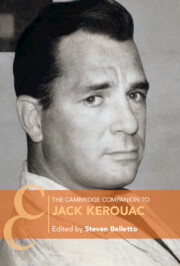Book contents
- The Cambridge Companion to Jack Kerouac
- The Cambridge Companion to Jack Kerouac
- Copyright page
- Contents
- Notes on Contributors
- A Kerouac Chronology
- Additional material
- Introduction
- Chapter 1 Kerouac’s Concept of His Duluoz Legend
- Chapter 2 Kerouac and the Profession of Authorship
- Chapter 3 Truth in Confession
- Chapter 4 The Textuality of Performance
- Chapter 5 The Spontaneous Aesthetic in The Subterraneans
- Chapter 6 Kerouac and the 1950s
- Chapter 7 The Impact of On the Road on the 1960s Counterculture
- Chapter 8 Vanity of Duluoz and the 1960s
- Chapter 9 Late Kerouac, or the Conflicted “King of the Beatniks”
- Chapter 10 Visions of Cody as Metafiction
- Chapter 11 Making the Past Present
- Chapter 12 Spun Rhythms
- Chapter 13 Kerouac’s Representations of Women
- Chapter 14 Kerouac and Blackness
- Chapter 15 Kerouac, Multilingualism, and Global Culture
- Chapter 16 The Two Phases of Jack Kerouac’s American Buddhism
- Chapter 17 Jack Kerouac’s Ambivalences as an Environmental Writer
- Chapter 18 The Essentials of Archival Prose
- Further Reading
- Index
- Cambridge Companions To …
Chapter 3 - Truth in Confession
The Foundation of Kerouac’s Literary Experiment
Published online by Cambridge University Press: 31 October 2024
- The Cambridge Companion to Jack Kerouac
- The Cambridge Companion to Jack Kerouac
- Copyright page
- Contents
- Notes on Contributors
- A Kerouac Chronology
- Additional material
- Introduction
- Chapter 1 Kerouac’s Concept of His Duluoz Legend
- Chapter 2 Kerouac and the Profession of Authorship
- Chapter 3 Truth in Confession
- Chapter 4 The Textuality of Performance
- Chapter 5 The Spontaneous Aesthetic in The Subterraneans
- Chapter 6 Kerouac and the 1950s
- Chapter 7 The Impact of On the Road on the 1960s Counterculture
- Chapter 8 Vanity of Duluoz and the 1960s
- Chapter 9 Late Kerouac, or the Conflicted “King of the Beatniks”
- Chapter 10 Visions of Cody as Metafiction
- Chapter 11 Making the Past Present
- Chapter 12 Spun Rhythms
- Chapter 13 Kerouac’s Representations of Women
- Chapter 14 Kerouac and Blackness
- Chapter 15 Kerouac, Multilingualism, and Global Culture
- Chapter 16 The Two Phases of Jack Kerouac’s American Buddhism
- Chapter 17 Jack Kerouac’s Ambivalences as an Environmental Writer
- Chapter 18 The Essentials of Archival Prose
- Further Reading
- Index
- Cambridge Companions To …
Summary
This chapter explores Kerouac’s rich understanding of literary history as manifested in his Duluoz Legend, focusing in particular on two mechanisms by which this understanding turns up in his work. The first mechanism was his deep desire to seek and speak the truth, as he wrestled with his need to lead a godly life, a product of his Catholic upbringing, while simultaneously recognizing the almost requisite demand that a great novelist experience the darkness of the human soul. The second is the confession, which was not the legal confession of a court room or the spiritual confession of the church, but the broader truth of any human being who follows a path to forgiveness and wholeness by repeatedly purging themselves of sin, guilt, or embarrassment. Kerouac consistently worked truth and confession together – often to the dismay of some readers – twinning and twining them as he grappled with his spiritual and bodily identity as an American writer living in two conflicting Americas, the “the essential and everlasting America” of the ethereal beauty and mysticism, and the post–World War II triumphalist America of materialism and militarization.
Keywords
- Type
- Chapter
- Information
- The Cambridge Companion to Jack Kerouac , pp. 38 - 52Publisher: Cambridge University PressPrint publication year: 2024

